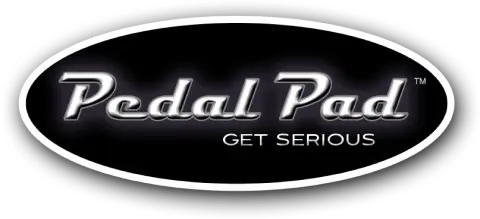the best pedal
board on the market
Pedal Pad is the pedal board guitar players stay with.
Other boards are mass-produced metal-stamped units that claim simplicity as a primary design feature. What is not simple, is removing them from their travel case or bag, plugging in numerous inputs and outputs all while dealing with a collection of dangling cables below the pedal surface. With Pedal Pad, you simply pop the-top, plug-in and play. Mass-produced guitar pedal boards also lack a lower compartment below the pedal-deck where cables and additional components, such as power supplies, can be stowed. With no lower compartment, the task of changing your pedal set-up becomes a time-consuming and arduous process of nesting and zip tying cables. The results are not always satisfying. Pedal Pad’s custom wood pedal boards, with their hinged
pedal deck, lower compartment and custom power and audio connector options, offer the ultimate solution to the organization of your unique pedal board set-up. So, when you feel like the simplicity of a mass-produced unit is no longer making your life simple, c’mon over to Pedal Pad and let’s get serious!
Other boards are mass-produced metal-stamped units that claim simplicity as a primary design feature. What is not simple, is removing them from their travel case or bag, plugging in numerous inputs and outputs all while dealing with a collection of dangling cables below the pedal surface. With Pedal Pad, you simply pop the-top, plug-in and play. Mass-produced guitar pedal boards also lack a lower compartment below the pedal-deck where cables and additional components, such as power supplies, can be stowed. With no lower compartment, the task of changing your pedal set-up becomes a time-consuming and arduous process of nesting and zip tying cables. The results are not always satisfying. Pedal Pad’s custom wood pedal boards, with their hinged
pedal deck, lower compartment and custom power and audio connector options, offer the
ultimate solution to the organization of your unique pedal board set-up. So, when you feel like the simplicity of a mass-produced unit is no longer making your life simple, c’mon over to Pedal Pad and let’s get serious!
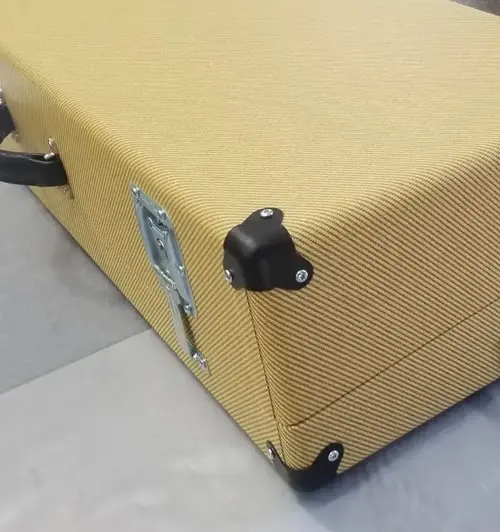

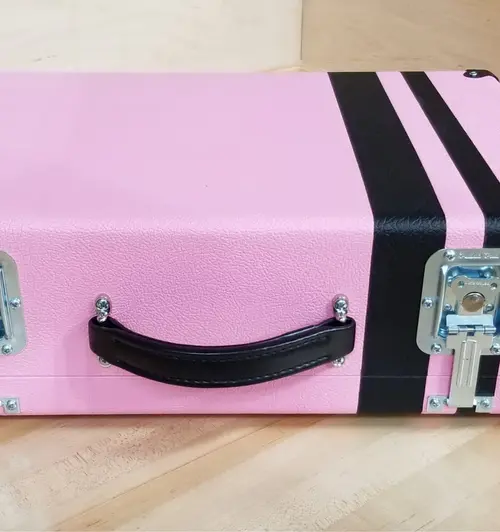
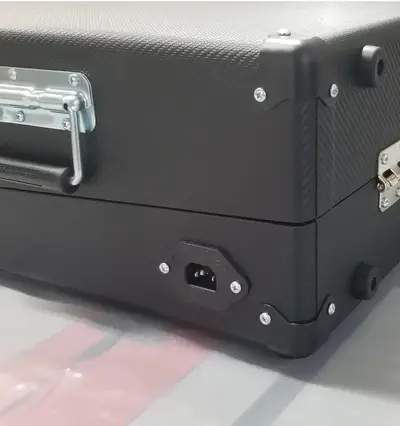
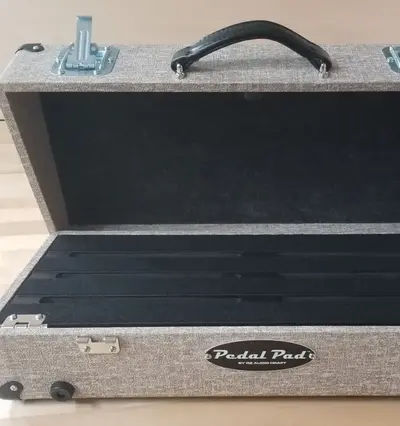
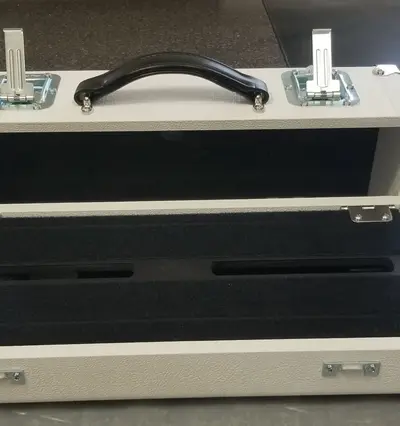
Get the Best Pedal Board Today
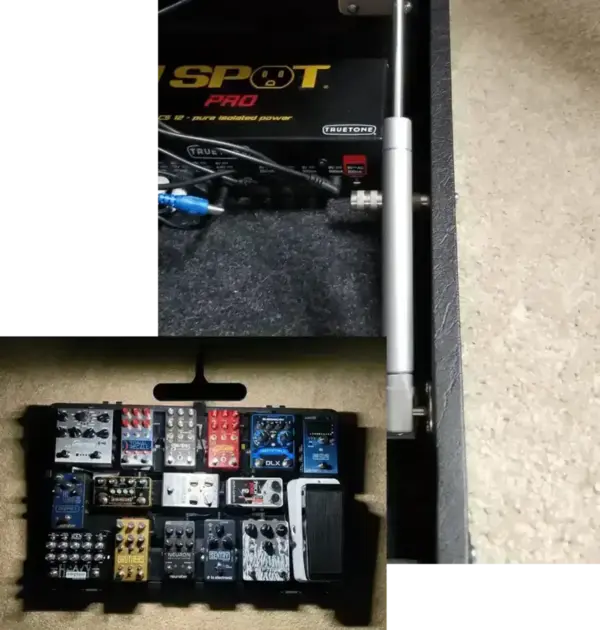
Testimonial
Frequently Asked Questions
- All in one durable pedalboard/case solution; just pop the top and play! No more pulling your board out of a soft case or gig bag!!
- Our pedalboards have a hinged pedal deck, allowing for cables, and additional pedals to be safely and neatly stowed underneath.
- 60+ Tolex and Tweed options are available
- ALL pedalboards are hand built from scratch in Coatesville, Pennsylvania
- The typical build time is 3-4 weeks. We meticulously construct every pedalboard from start to finish. Well worth the wait!
You will receive email notifications every step of the way!
- Pedalboard size depends on several things, including how many pedals you have/want, the form factor of those pedals, and the space between the pedals to accommodate the size of your feet. We recommend laying out your pedals and configuring them the way you want to assess the overall footprint and feel. Always keep in mind which cables you’re going to use, especially if you’re using a brand new pedalboard because some cables take up a lot more space than others. To help you choose the right size, we have a printable size guide that you can use to find a pedalboard that meets your needs. You can find it HERE! Don’t have your pedals yet? Websites like PedalPlayground.com offer an accurate and intuitive interface to lay out your pedals visually.
- We offer a huge range of sizes, but most boards range from 15-30 pounds. Yes, that’s a huge spread, so if you’re concerned and want to see more pedalboard deals before placing an order, please reach out with an estimated size so we can dial it in closer for you. REMEMBER – This is a case and pedalboard all in one. Our Baltic birch construction is obviously a little heavier than aluminum boards, but the benefit of customization and ALL-IN-ONE convenience is well worth it.
- Aluminum is by far the most common material pedalboards are made from. It offers a great strength-to-weight ratio and is relatively inexpensive. This is a great option for a “fixed” set of sizes and options because welding and powder coating custom options per order just wouldn’t be practical or economical. This is why mass-produced boards offer the most common sizes that suit most people’s needs so that they can be bulk ordered and inventoried for quick delivery. Here at Pedal Pad, we build every pedalboard to order with Baltic birch plywood, which is the strongest and most stable plywood in the world. While slightly heavier than aluminum, it allows us to offer many more standard options while still allowing for ANY customization on the fly. ONE-SIZE-FITS-MOST is not our goal here. If you can imagine it, we will build it! Check out our quality guide HERE!
- We strive to stock every audio and power connector you will ever need! Pedal Pad pedalboards are only outfitted with quality jacks such as Neutrik, Switchcraft, ST-Professional Italy, and other future brands, and other accessories. What’s not included: power supply mounting.. All options are non-solder pass-thru style. They occupy minimal space and offer an efficient setup. Our power connectors are US standard 3 prongs on the inside so that you can plug in your power supply, power strips, wall warts, etc. The outside is a standard IEC male connector, just like most supplies have.
- Absolutely. Don’t stress about not having enough jacks. If you need more in the future, we will provide you with the hardware needed and the support to install it. All you will need is a power drill. It’s a piece of cake!
- We have now included extended lid sizes for the STUDIO III, PHAT III, AXS III, and AXS III Mini models. Every lid will have a space of 3.75 inches on the spectator side and a 3-inch gap beneath the pedal deck. All Series pedal boards with extended lids will feature a front lip of 2.5 inches instead of the regular 1.625 inches, making them more like the DEEP III or DEEP-ER III.
- Are you having trouble with pedal pad configuration or pedal pads that don’t fit onto your pedal board? Our extended lids were designed to solve this problem. With an extended lid, the players can add taller pedals or design their own configuration without worrying about clearance difficulties underneath the lid. Moreover, the storage space below the deck will not change, and the Pedal Pad’s base will maintain its current proportions.
- Every pedalboard we offer has a hinged pedal deck with loop-style Velcro pre-installed on the slats. We also provide ample “hook” Velcro to adhere to your pedals for a secure mount to the pedal deck. Our hook/loop’s Velcro-style fasteners are extremely robust and will keep your pedals exactly where you want them!
- Every Pedal Pad has an industrial carpet installed on the base and lid. Velcro sticks extremely well to this carpet, and most of the time, this is sufficient. In the unlikely circumstance that you will need to adjust component placement consistently, Velcro is a better option as its holding strength doesn’t degrade as quickly with placement changes.
- While there is no right or wrong order to place your effects, there is a very logical basis to start. Effects pedals are designed to alter your signal in order to create a specific “effect” or change on the original signal. Your signal will be changed as you pass through each pedal. The order we choose to manipulate our signal from start to end creates different results. Here is a great place to start, and by no means is it meant to inhibit experimentation.
- TUNER – Accurate tuning is best achieved by an unaffected signal
- WAH OR VOLUME PEDAL
- COMPRESSOR
- EQ
- PITCH SHIFTERS, HARMONIZERS, OCTAVE PEDALS
- GAIN (fuzz, overdrive, distortion, etc.)
- MODULATION (chorus, flanger, phaser, tremolo)
- VOLUME (AGAIN!) – This is another good spot for a volume pedal. Raising/lowering the volume level at this stage won’t affect any pedals before it but allows delay and reverb effect “trails” to ring out.
- DELAY
- REVERB
- True bypass is a term that is thrown around a lot in the pedalboard community. True bypass simply means that when an effect pedal is disengaged or “off,” the signal is passing through the pedal as if the circuitry of the pedal was not there. No interference. The problem is, the more true bypass pedals your signal passes through, the weaker it becomes. This can lead to high-end frequency loss and perceived volume drop. Sometimes a boost is necessary! This is where a quality buffer comes in. A good buffer will strengthen your signal to pass through many pedals and lengths of cable without affecting the core of your tone. A quality buffer will never hurt you UNLESS you are running it before plugging into some vintage effects like old fuzz boxes. In this case, keep your vintage fuzzes before the buffer, and you’re good to go!
- Often referred to as simply “switchers,” these handy devices allow you to connect pedals to an individual loop or “chain” that can be added or removed with the push of a footswitch. For example, you have 2 overdrive pedals that you always run at the same time. They can be grouped on a loop of the switcher and then engaged with one footswitch vs. two. Just leave both pedals on, and no more worries about tap dancing around multiple pedals. When the loop is disengaged, it is entirely removed from your signal chain, keeping it shorter and stronger. Matrix Switching Pedal Switching systems such as The GIGRIG G3, BOSS ES-8, Musicom Lab, and some others offer a powerful tool called matrix switching. This technology allows for your pedal loops to be re-ordered on the fly, thus enabling more sound creativity and experimentation. No more fretting about pedal placement!
- Currently, we ship to the USA, UK, and Europe.
-
- Get in touch with us by completing the online form on our “Contact” page. Alternatively, you can call us at 1+ (484) 424-3480 or send an email to contact@pedalpad.com.
- OZ Audio Craft, LLC warrants all pedalboards and products to be free of all defects in material and workmanship under normal use for one (1) year from the delivery date. Within the period of this warranty, OZ Audio Craft, LLC will repair or replace, free of charge, any product or part proving defective in material or workmanship. Repair or replacement options will be determined by OZ Audio Craft, LLC.
Limitation of Damages
- In no event shall OZ Audio Craft, LLC be liable for consequential and incidental damages for breach of this warranty. Some states do not allow the exclusion or limitation of incidental or consequential damages, so the above limitation or exclusion may not apply to the buyer. All expenses related to replacing or repairing a defective part under this warranty shall be assumed by OZ Audio Craft, LLC, except for Shipping, which the customer will prepay.
Warranty Exclusions
- This warranty does not apply to any costs, repairs, or replacements for the following: Damage resulting from misuse, abuse, accidents, alterations, or misapplication. Corrective work is necessitated by repairs made by anyone other than OZ Audio Craft, LLC.
How to Obtain Warranty Service
- Upon discovering any defect, malfunction, or nonconformity in the Covered Product, the customer must immediately contact OZ Audio Craft, LLC for options to obtain warranty service or repairs. Upon approved warranty service and/or replacement, the customer should:
- Take pictures of the product before shipment
- Carefully pack the Covered Product, preferably in the original packing materials, and deliver it to:
- OZ Audio Craft, LLC
- 239 Hurley Road
- Coatesville, PA 19320 We recommend that the buyer insure any products sent by mail/freight. We accept no liability for products lost or misplaced in shipment.
- Pedal Pad DOES NOT accept returns on any style board. This is to include In Stock Now Boards of any style or model. We also DO NOT accept returns of any accessories unless they are broken or defective.
Returns
- Absolutely! We offer the option to purchase gift cards to the value of $25 to $400. Simply select an amount and proceed to checkout. Keep in mind that our gift cards are digital, and we don’t send physical cards.
- Once you make your purchase, we’ll send you an email with the gift card, along with a few instructions on how to use it, which you can then send to the recipient. The gift card can be used for anything on our website.
- While it is more than feasible to get by with just a few stompboxes, you are most certainly not going to quit collecting them anytime soon.
- Guitar pedals may help you attain your dream tone and enable you to produce fantastic sounds.
- Having too many pedals, though, can be problematic. One of the best pedalboards can be used in this situation.
- You may organize the jumble of boxes and cables at your feet with these pre-made boards, and it will be simpler to turn each pedal on and off when you are bouncing around on stage.
- While a few of these products have up to eight pedals and soft power supply mounting, these are not the main attractions.
- Ultimately, you need a solid pedalboard that offers you convenience so that you can perform your best on stage.
- Whether or not your previous pedal board utilized a power supply, the Pedal Pad makes mounting your favorite power supply easy and offers numerous benefits that improve sound quality.
- Just like an EQ pedal can give an overdrive pedal a hint of brightness, our connections add to the clarity of your audio output. Ultimately, this is what all guitar players want on stage.
- Therefore, if you want the best pedalboard on the market, the Pedal Pad offers a number of benefits. From aesthetics to better sound quality, you’ll get it all!
- Every pedalboard we offer has a hinged pedal deck with loop-style Velcro pre-installed on the slats. We also provide ample “hook” Velcro to adhere to your pedals for a secure mount to the pedal deck. Our hook/loop’s Velcro-style fasteners are extremely robust and will keep your pedals exactly where you want them!
- Yes, we do! Please get in touch with us to find out whether we can design a custom extended lid for your pedal board, and we’ll send you a quote!
